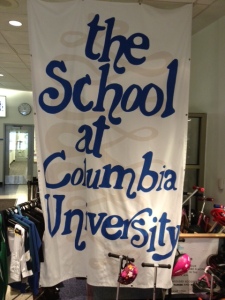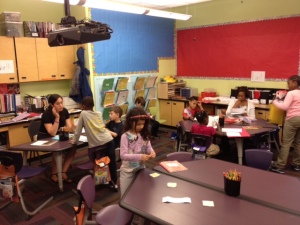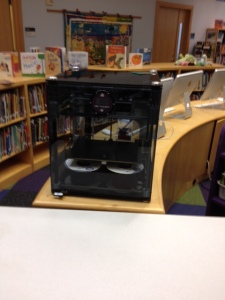This will be a somewhat abbreviated post, not because The School at Columbia University has little to report, but because it has become a well-known stop on school tours of the northeast and many of you know their story. I spent an hour and a half with Don Buckley, Director of Technology and Innovation and tried to download his views of what, other than the governing structure, makes The School unique.
 The basics: The School at Columbia is an independent K-8 school started about 10 years ago by Columbia University, primarily so university faculty would have a place to send their children in the highly competitive NYC independent school market. It is run by an oversight council appointed by the Columbia trustees. About half of the 500 students are related to the university and the other half come from the local uptown/Harlem area, making this a truly urban, and highly diverse school in every way imaginable: socially, ethnically, economically, and academically. At its heart it is a lab school, and the nearly 100 faculty include specialists in literacy, math, technology, and special needs. While the student:teacher ratio is 5:1, average class sizes are 16-20. They give grades starting in grade 6, and are an ERB-testing school, as these are needed for the many students who go on to independent and highly competitive public high schools.
The basics: The School at Columbia is an independent K-8 school started about 10 years ago by Columbia University, primarily so university faculty would have a place to send their children in the highly competitive NYC independent school market. It is run by an oversight council appointed by the Columbia trustees. About half of the 500 students are related to the university and the other half come from the local uptown/Harlem area, making this a truly urban, and highly diverse school in every way imaginable: socially, ethnically, economically, and academically. At its heart it is a lab school, and the nearly 100 faculty include specialists in literacy, math, technology, and special needs. While the student:teacher ratio is 5:1, average class sizes are 16-20. They give grades starting in grade 6, and are an ERB-testing school, as these are needed for the many students who go on to independent and highly competitive public high schools.
 Don agrees that terms like “progressive” and “21C” are either outdated or just wrong, but we know what they mean, and The School is it. Learning is based on inquiry, experience, and ample technology for any teacher’s dream. Importantly, though, Don and his team of ed-tech specialists don’t tell the teachers what to use. Teachers choose, but then they have to own the technology and know how to use it as they wish. Don and team have built their own YouTube and Flickr knock-offs out of open source software so even the youngest students can use real-world applications without actually going on the open Internet. They can work in this “walled garden” as they learn how to create and bring information together so they will have the skills as they get older and surf out into real cyberspace.
Don agrees that terms like “progressive” and “21C” are either outdated or just wrong, but we know what they mean, and The School is it. Learning is based on inquiry, experience, and ample technology for any teacher’s dream. Importantly, though, Don and his team of ed-tech specialists don’t tell the teachers what to use. Teachers choose, but then they have to own the technology and know how to use it as they wish. Don and team have built their own YouTube and Flickr knock-offs out of open source software so even the youngest students can use real-world applications without actually going on the open Internet. They can work in this “walled garden” as they learn how to create and bring information together so they will have the skills as they get older and surf out into real cyberspace.
Curriculum is organized around grade level “integrated themes and concepts” (these are on their web site) which provide an overarching framework of learning goals. Don says they use a lot of backward design, Grant Wiggins scaffolding, and Don does design thinking workshops for his and other schools.
As we walked around the building, which was constructed from the ground up, a few other points to note, particularly in relation to my reporting from other schools on this journey:
- New schools do not generally have one of the key innovation stumbling blocks: inertia, and The School does not have the other: fear.
- They have a young faculty; I don’t think I saw more than 2-3 faculty who looked like they were much over 35. Youth does not guarantee more ready acceptance of innovation, particularly if it is tech-heavy, but it sure helps.
- Many other NYC schools are teach in really cramped spaces governed by the structural elements of original, now outdated, buildings. The School was built as a school, so, for example, the art studios have high ceilings, lots of light, and a very artsy feel.
- Don’s insistence that faculty own their innovations develops a mindset of teacher as evolving learner. Is that a dominant mindset at your school?
- Having a 3D printer in the library is pretty darn cool; kids design everything from medieval castles to model furniture and then go print/build it in the library.
The School gets a lot of visitors. Don recalled a group of Bulgarians interested in how they are using iPads and laptops, a group of Koreans who want to open a new Samsung school in Seoul, and a delegation sent over by the Chinese embassy. I was honored to get his time and a tour. Mark your NAIS calendars: Don, Jamie Baker, Jason Ramsden, and I are giving a three-hour session that I think will be both interesting and highly active.





[…] This will be a somewhat abbreviated post, not because The School at Columbia University has little to report, but because it has become a well-known stop on school tours of the northeast and many o… […]
Glad that you had a chance to meet Don and have such a great walk around at The School at Columbia. Looking forward to our presentation at NAIS!